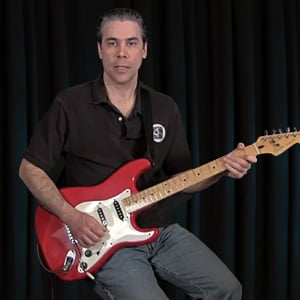Description
Understanding how chords are formed and voiced is a very powerful concept that can open up the entire fretboard for your use and as a result make your playing more musical.
Major chords are defined as the 1st, 3rd & 5th note of a major scale isolated and, or played together. Let's start with a C major scale.
c(1) - d(2) - e(3) - f(4) - g(5) - a(6) - b(7) - c(1)
So, a C major chord consists of the notes c(1), e(3) and g(5) played together. Three notes played together as a chord is called a triad. Anywhere, on any musical instrument you play those 3 notes together is a C major chord. On the guitar, we can play this basic triad of the C major chord as part of the open C major chord we are familar with as beginners.
The reason we can add the other finger and strings is because it's a convenient way to isolate and play more of the same notes. In fact, every open chord you learn on the guitar as a beginner is some practical way of isolating only the 1-3-5 of a scale in order to play it's related chord. In the lesson I demonstrate that for all the major open chords.
Scale degrees are also the source of chords names and symbols containing numbers. The number in the chord name is the scale degree added to the chord voicing. I have another set of tutorials aimed at extended harmony chords such as 7th, 9th, 11th, 13th.
Extended Harmony Chords Series 1
Extended Harmony Chords Series 2
Extended Harmony Chords Series 3
Lesson Info
Tutorial Lessons
- Chord Theory: Introduction
- Major Chords
- Moveable Major Chords
- Major Triads & Inversions
- Major Chord Voicings Across The Fretboard
- Minor Chords
- Moveable Minor Chords
- Minor Triads & Inversions
- Minor Chord Voicings Across The Fretboard
- Practical Applications: Musical Direction
- Practical Applications: Register
- Practical Applications: Accompaniment
- Practical Applications: Embellishments
- Chord Theory: Conclusion
